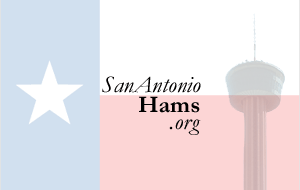 San Antonio Area Hams
San Antonio Area Hams 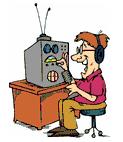
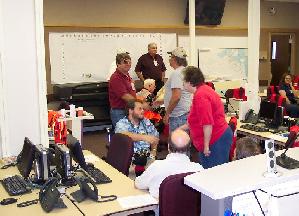
Click Here for 2007 Archive
Click Here for 2006 Archive
Click Here for 2005 Archive
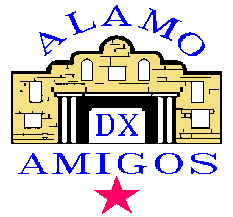 Alamo DX Amigos has closed their club doors after many years of fun in the ham community. San Antonio Hams just got an email from the former Treasurer/Webmaster of Alamo DX Amigos, Robert KM5RG, that as of the end of 2005, the DX Amigos has disbanded. Their club website is also down
Alamo DX Amigos has closed their club doors after many years of fun in the ham community. San Antonio Hams just got an email from the former Treasurer/Webmaster of Alamo DX Amigos, Robert KM5RG, that as of the end of 2005, the DX Amigos has disbanded. Their club website is also down
AMATEUR RADIO STATION LOG FORMS
| While the old original, never fails, log form is the yellow legal pad, some radio operators find it easier to fill in the blanks on a pre-existing log form to handle radio traffic passing thru their assigned station. We have developed two variations of this log form for you to use, one designed for HF traffic where frequencies can and will change during your shift, another for local VHF/UHF type traffic where the net is usually on the same repeater / frequency. | ||
| Both forms are similar and could actually be used for either purpose. These forms are in Adobe PDF format ready for printing on standard letter sized paper of your choice. Click on the images below to view the files and save / print to your computer. | Type 1 Log Form for HF operations 
|
|
Hurricane Rita - San Antonio Hams Respond With Help
The photo on the left shows the first group of seven hams to be briefed and issued Alamo Regional Citizens Corp ID tags by the Incident Command Post (ICP) authorities at Kelly USA on Thursday, September 22, 2005. Photo (left to right) Barry W5BLH, Bob K5AUW, Neil WA5FSR, Louise WB5LCT, Mark KD7MQX, Lee N5NTG, Lew KD5MSW. Photo below shows Barry W5BLH and Lee N5NTG (on microphone) at the ICP radio control station. Allen Shoults (South Texas K9 Search and Rescue) is the guy on the cell phone. Lists of current shelter activity on whiteboard behind Barry, other maps on the wall showing shelter locations on Kelly and around San Antonio.
 A total of forty-six (46) hams are known responded locally to provide coverage of as many as eleven simultaneous locations around San Antonio, with coordination from the Kelly USA ICP net control station. Bexar County ARES was the coordinating agency who lined up and scheduled hams to serve at the various locations. Net Control was using K5BCA, which is the Bexar County ARES call sign. Other local hams helped with the ARES HF nets as net control in shifts.
A total of forty-six (46) hams are known responded locally to provide coverage of as many as eleven simultaneous locations around San Antonio, with coordination from the Kelly USA ICP net control station. Bexar County ARES was the coordinating agency who lined up and scheduled hams to serve at the various locations. Net Control was using K5BCA, which is the Bexar County ARES call sign. Other local hams helped with the ARES HF nets as net control in shifts.
Security in shelters was a lot tighter this hurricane, as compared with Hurricane Katrina, based upon lessons learned from that experience. All hams working shelters received their credentials at the ICP BEFORE they assumed any assignments, unless those assignments don't involve shelters or other disaster scenes. (i.e. relaying HF from home, calling on phone/radio to get more volunteers, etc.)
The ICP was running on Amateur 146.94 repeater using call sign K5BCA (Bexar County ARES) and hams were instructed to contact ICP prior to arriving for credentials to be sure the proper officials are present to issue them.
 Stan KD5ZSY (photo left) was operating Saturday at the Walmart Shelter (loop 410 and Hwy 151) where over 2100 evacuees were provided shelter. Behind him you can see the shelter operations.
Stan KD5ZSY (photo left) was operating Saturday at the Walmart Shelter (loop 410 and Hwy 151) where over 2100 evacuees were provided shelter. Behind him you can see the shelter operations.
 In the photo below, Stan talks with some of the Red Cross Shelter Staff to get the most recent occupancy count (number of evacuees still registered at this shelter). Click on either photo for larger view.
In the photo below, Stan talks with some of the Red Cross Shelter Staff to get the most recent occupancy count (number of evacuees still registered at this shelter). Click on either photo for larger view.
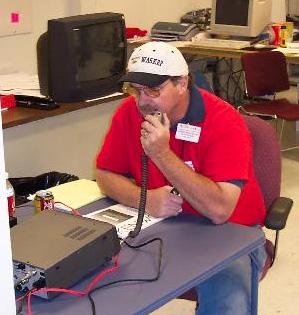 Windsor Park Mall in the former Montgomery Wards Store was the home of as many as 3,300 evacuees during the peak time on Saturday.
Windsor Park Mall in the former Montgomery Wards Store was the home of as many as 3,300 evacuees during the peak time on Saturday.
In the photos shown here, Danny WA5KRP (left) responds to a request from net control asking if there were any residents in the shelter requiring bus transportation to Corpus Christi (wanting to return home).
After checking with the transportation manager from the Red Cross Shelter Operations, he determined a bus had departed about an hour prior to the inquiry and no more shelter residents were needing such transportation. Gloria KE5CVA joined Danny on Sunday afternoon to get some more experience on how this operation was handled. Other operators here on earlier shifts included Robert K5BRP, Claude KD5YZX not shown in photo.
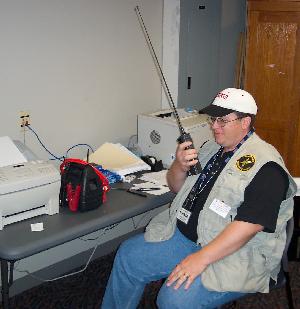 Shane NS5D worked shifts on HF ARES nets, as did Don AC5XK, Connie KD5UXU, Everett W4RRX (and others). Shane and relieved some very tired operators, Charlie KD5EXS at Reagan HS plus Bob W5AUW and Barry W5BLH at the American Red Cross Headquarters' EOC (Emergency Operations Center). Due to the metal building and no exterior antennas, Bob, Barry and Shane used cross band functions on their mobile radios out in the parking lot and their HTs inside to reach the repeater for communications with net control at Kelly, about 15 miles away.
Shane NS5D worked shifts on HF ARES nets, as did Don AC5XK, Connie KD5UXU, Everett W4RRX (and others). Shane and relieved some very tired operators, Charlie KD5EXS at Reagan HS plus Bob W5AUW and Barry W5BLH at the American Red Cross Headquarters' EOC (Emergency Operations Center). Due to the metal building and no exterior antennas, Bob, Barry and Shane used cross band functions on their mobile radios out in the parking lot and their HTs inside to reach the repeater for communications with net control at Kelly, about 15 miles away.
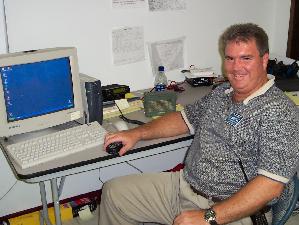 The final net control station of this four day operation was John WB5YQC. John is also the Bexar County ARES Information Officer, and it was his Heathkit speaker that was used with the county provided 2 meter ham radio to help us hear the audio signal in what at times was a very high noise environment. There were many net controls over the four day period, including Lee N5NTG, Charlie KC5NKK (and wife Patti), Neil WA5FSR, Louise WB5LCT, Bill N5TCT, Brian NB5R, Pat AD5BR and others that I might have missed hearing while trying to catch some sleep between shifts
The final net control station of this four day operation was John WB5YQC. John is also the Bexar County ARES Information Officer, and it was his Heathkit speaker that was used with the county provided 2 meter ham radio to help us hear the audio signal in what at times was a very high noise environment. There were many net controls over the four day period, including Lee N5NTG, Charlie KC5NKK (and wife Patti), Neil WA5FSR, Louise WB5LCT, Bill N5TCT, Brian NB5R, Pat AD5BR and others that I might have missed hearing while trying to catch some sleep between shifts
Here is a list of the forty-six (46) known ham operators at local shelters or serving in other functions included (in somewhat alphabetical first name order) Barry W5BLH, Ben N5BMW, Billy N5TCT, Bob K5AUW, Brian NB5R, Charles KD5EXS, Charlie KC5NKK, Chris KD5KUV, Christina W5CLS, Chuck WB5FWI, Claude KD5YZX, Danny WA5KRP, David KD5NNH, Don AC5XK, E.W. KD5T, Eric W5ETS, Gloria KE5CVA, Greg KD5BVG, Herm N5CNH, Jeremy KE5ELI, Jimmy AB5WZ, Joe KD5FMU, John WB5YQC, Johnny K5POP, Karen K5DRK, Lee N5NTG, Lew KD5MSW, Louise WB5LCT, Luis N7PLC, Margie KE5GAK, Mark KD7MQX, Marty KB5MJC, Marty NS5H, Mike K5UCQ, Mike KD5OZM, Mike KB0LZQ, Neil WA5FSR, Pablo KC5OZN, Pat AD5BR, Robert K5RPB, Shane NS5D, Stan KA5IID, Stan KD5ZSY, Susan KE5CPQ, Teri KC5BJI, and Witt KE5DPU. I'll update this list if other names or corrections are provided to me.
A special thanks to Erik W5ETS who jumped in when someone "accidently" linked the 444.100 repeater over to the 146.94, and to Gordon K5SUZ, who arranged to have that connection "un-linked" fairly quickly. Net operations at all locations were secured at 7pm local time on Sunday, after having been started at 1pm on Thursday. Net was run from 1pm until 10pm Thursday, 7am Friday round the clock until 10pm Saturday, and Sunday from 6:45am until 7pm.
Even though there was no declared communications emergency in San Antonio, the problem caused by so many cell phone users being in one location (large shelters with 2-5,000 occupants each) caused local cell sites to be overloaded on frequent basis. Other interuptions of phone service (temp phone lines installed at some shelters in a hurry) caused the need to rely more on ham operators as the situation evolved over the four days. Ham Radio Operators provided key critical communications in a timely manner, including putting various Red Cross officials in direct third party traffic to resolve issues when their cell phones or land lines were busy or unable to connect.
Emergency HF Traffic Nets - CLICK HERE FOR LIST
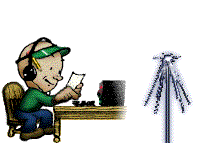 We've recently gotten lots of emails asking about why we didn't have HF nets listed. No particular reason other than this web site has had a local only focus. But with the Hurricane Katrina visiting next door, these HF nets have become very active and very important to the disaster response efforts of this nation. Below is a list of known nets on 80, 40 and 20 meters. Some frequencies are used only in daytime and others at night. Some are used 24/7.
We've recently gotten lots of emails asking about why we didn't have HF nets listed. No particular reason other than this web site has had a local only focus. But with the Hurricane Katrina visiting next door, these HF nets have become very active and very important to the disaster response efforts of this nation. Below is a list of known nets on 80, 40 and 20 meters. Some frequencies are used only in daytime and others at night. Some are used 24/7.
Be sure to listen to nets first, follow net control's instructions, and don't transmit unless you really have something they need to know, or you can handle a piece of traffic that they need to pass into your area. They don't need folks "just checking in for the count", a common practice on the local VHF 2-meter traffic nets. Also, please be courteous by not operating nearby the nets, frequency wise, or operator wise, to avoid bleed-over or other interference. Emergency nets are serious busines, and only the "professional" amateur need apply.
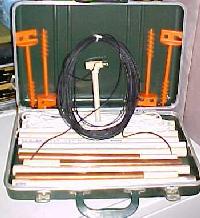 TEXAS NVIS ANTENNA KIT - Version 2
TEXAS NVIS ANTENNA KIT - Version 2
As shown in the picture to the right, I again have made a few minor changes to the NVIS antenna kit. I replaced the hammer-in support rope stakes with a screw-in variety. At first I thought that they wouldn't be able to withstand the torque or pullout stress. A few tests showed me I was wrong. They are easy to use and easier to remove from either soft or hard soil while still supplying enough strength so that they won't pull out like a conventional stake might.
The picture also shows the kit without the coax cable and ground reflector system that were a part of my other pictures. I did this to give you a better view of the antenna, itself. The ground reflector system is very important in creating the RF waveform needed for NVIS signals and I have designed a reflector system which is easy to deploy yet suits the ground conductivity of our area. It took many field strength experiments to come up with the ideal reflector design.
There are three antenna supports, all of which are 5 feet tall when assembled. This height, after field testing, I feel is not only RF adequate to create the "half grapefruit" lobe needed for communications within a 400 mile circular range but it also makes the antenna easier to handle and construct. With this height above ground, it also means that it lessens the reception of both static crashes AND European broadcasters on 40 meters making it very valuable during emergency communications in south Texas. If every emergency communications operation in south Texas, that used HF, were wise enough to also use the same type of antenna system it would make a very reliable communications web between all counties. I have also designed a NVIS antenna system which will create the same radiation pattern when it is installed on the roof of a building, such as at an emergency operations center. The reflector system is completely different to compensate for "pooling" and nearby metal structures.
Visit http://hometown.aol.com/alonestaryank/NVISKIT.html for more details, construction instructions and full parts list for building your own portable Texas NVIS Antenna.
73 de Bob W2IK
JULY 2005 - FCC PROPOSES DROPPING MORSE CODE REQUIREMENT

The FCC has proposed dropping the 5 WPM Morse code element as a requirement to obtain an Amateur Radio license of any class. The Commission included the provision in a July 19 Notice of Proposed Rule Making and Order (NPRM&O) in WT Docket 05-235, but it declined to go along with any other proposed changes to Amateur Service licensing rules or operating privileges. Dropping the Morse code requirement or any other changes to Part 97 would not become final until the Commission gathers additional public comments, formally adopts any new rules and concludes the proceeding with a Report and Order specifying the changes and an effective date. That's not likely to happen for several months.
"Based upon the petitions and comments, we propose to amend our amateur service rules to eliminate the requirement that individuals pass a telegraphy examination in order to qualify for any amateur radio operator license," the FCC said. The NPRM&O consolidated 18 petitions for rule making from the amateur community. Several petitioners simply asked the FCC to drop the Morse requirement, but some--including the ARRL--also proposed a wide range of additional changes to the amateur rules. The FCC said the various petitions had attracted 6200 comments from the amateur community, which soon will have the opportunity to comment again--this time on what the FCC calls"our tentative conclusions" in its NPRM&O.
The Commission said it believes dropping the 5 WPM Morse examination would encourage more people to become Amateur Radio operators and would eliminate a requirement that's "now unnecessary" and may discourage current licensees from advancing their skills. It also said the change would "promote more efficient use" of amateur spectrum.
To support dropping the code requirement, the FCC cited changes in Article 25 of the international Radio Regulations adopted at World Radiocommunication Conference 2003. WRC-03 deleted the Morse testing requirement for amateur applicants seeking HF privileges and left it up to individual countries to determine whether or not they want to mandate Morse testing. Several countries already have dropped their Morse requirements for HF access.
The NPRM&O is on the FCC Web site in Adobe PDF format. A 60-day period for the public to comment on the NPRM&O in WT 05-235 will begin once the notice appears in the Federal Register. Reply comments will be due within 75 days.
Source: The ARRL Letter, Vol 24, No 28. More info at www.ARRL.org web site.

About Us | Privacy Policy | Contact Us | ©2003-2009 Lee W. Besing, N5NTG - San Antonio Hams